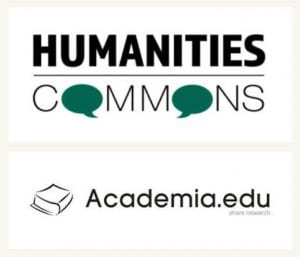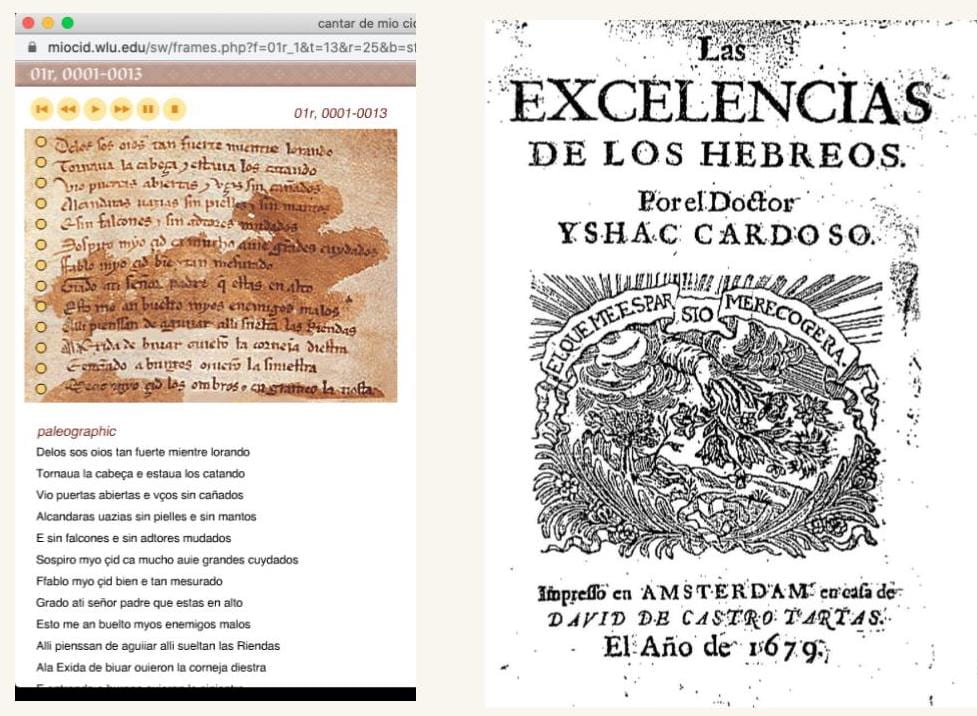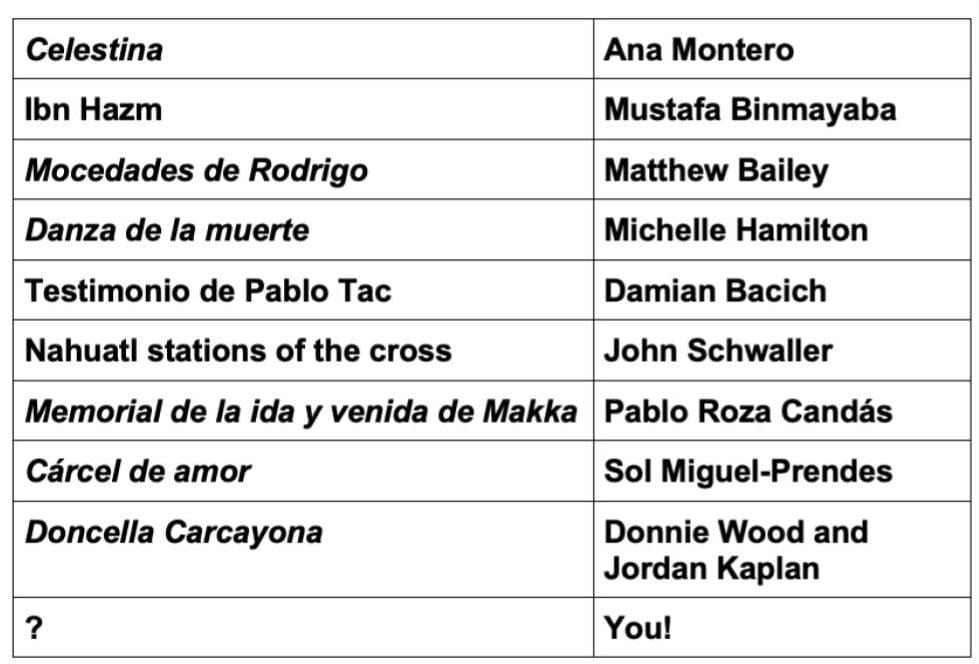 Anyone who has taught panoramic survey courses of literature knows the frustration of working with published textbooks. I’ve argued both sides of the question in my blog: [pro-textbook] [anti-textbok]. Ultimately no one textbook can serve the curricular and pedagogical needs of any one instructor in any given class. Bound printed textbooks are shaped by market considerations and tend toward highly canonical selections from Castilian authors that no longer reflect the literary history practiced by most scholars of Iberian literatures (I talked about this lag between research and pedagogy at the MLA back in 2008). Curricular aims and time schedules vary considerably by institution and by instructor. It is extremely difficult to find a textbook of medieval Iberian literature that satisfies the pedagogical interests of the instructor and the economic interests of the student.
Anyone who has taught panoramic survey courses of literature knows the frustration of working with published textbooks. I’ve argued both sides of the question in my blog: [pro-textbook] [anti-textbok]. Ultimately no one textbook can serve the curricular and pedagogical needs of any one instructor in any given class. Bound printed textbooks are shaped by market considerations and tend toward highly canonical selections from Castilian authors that no longer reflect the literary history practiced by most scholars of Iberian literatures (I talked about this lag between research and pedagogy at the MLA back in 2008). Curricular aims and time schedules vary considerably by institution and by instructor. It is extremely difficult to find a textbook of medieval Iberian literature that satisfies the pedagogical interests of the instructor and the economic interests of the student.

Print textbooks in general are becoming more expensive, outpacing inflation and adding increased financial burden to university students who are bearing ever-increasing debt loads. In addition to their cost, traditional print textbooks are inflexible, forcing instructors —many of whom are already time starved, with high teaching loads and increasing service burdens— to subordinate their own pedagogical interests and strengths to the materials and approaches offered by traditional print textbooks. This state of affairs is one in which market forces are distorting the way in which we represent Iberian cultures to our students.
Most instructors working in the field end up either adopting a traditional print textbook, supplementing with photocopied course packets and from other texts or of their own edition. Many of us are constantly reinventing the wheel. As a result, there is a tremendous amount of pedagogical material being developed that might well be put in the service of the wider community of teachers and learners of premodern Iberian cultures, under an open license that permits the broadest possible diffusion without concern (or the performance of concern) for copyright fees.
There has been talk of addressing this issue, at least the curricular issue, by collaborating on a newer, more inclusive teaching anthology, a sort of literary companion to Remie Constable’s Medieval Iberia. This is a wonderful idea, one whose time came a while ago. However, many colleagues, myself included, will find it difficult to commit to such a project, which by its nature demands the involvement of specialists in the many languages involved over several years and to the tune of many, many, hours. A further disincentive is that such work is not properly rewarded by most research institutions, so that one’s limited time for research (which is rewarded, in theory) becomes more limited.
As a compromise (or perhaps a cop-out), I proposed a different model of online resource, one that offers maximum flexibility to instructors, minimal costs to students, and a manageable time investment on the part of faculty.
Open Iberia/América is a collection of short selections of premodern Iberian and Latin American texts in pedagogical editions modeled after the editorial practices of commercial anthologies. Editors select a short text or excerpt which they gloss for undergraduate readers (the target population is undergraduate students in third-year courses in US universities) write short introductions, study questions, and provide a basic bibliography for further reading. The commitment is low, and the texts can be one that you are currently editing or studying. The collection is edited by subject experts, and is available under a Creative Commons open access license that allows users to download, copy, distribute, alter, republish the units provided they attribute the source.
Audience? How does the format determine the audience?

source: pixbay.com
I imagined the audience as instructors and students of university classes in Hispanic literatures and perhaps history, religious studies, and other related topics. I also imagined it might be used by high school instructors of these topics in the US, UK, and the Spanish-speaking world. Each text is published in two versions: one with the text in the original language accompanied by an introduction, translation, and notes in English, and another version with the introduction, translation, and notes in Spanish. This way each can be used in courses in which the language of instruction is either English or Spanish. In courses taught in Spanish for non-native speakers of Spanish in the English-speaking world, the students have the option to consult the English-language version as a support. However, Open Access publications have an open-ended audience; anyone with an internet connection is able to access and download the texts, so this might include interested general readers, high school students, and instructors and students at low-resourced institutions worldwide. Some of the units in the collection cut across disciplinary areas, so that, for example, my unit on Isaac Cardoso could be taught in a course on Judaic Studies in English or Spanish; the unit on Ramon Muntaner could be taught in a History course in either language, and so forth.
Anthology or Archive?

In planning this project, I had to think what shape it would take, and why. I wanted it to respond to the needs of the instructors and students, or at least my understanding of their and our needs, but I also wanted colleagues to be motivated to contribute. A print anthology is closed, in the sense that the editor or editors plan a determined number of contributions, solicit them, and publish them. Their editorial vision shapes the collection, which in turn determines the parameters of how one might use it in the classroom. However, for this project, I wanted to take advantage of digital publishing tools that would allow us to create an open-ended collection or archive rather than a closed anthology. This way we could keep adding to it indefinitely, and the collection could grow in response to the interest level and focus of the contributors. In balancing the needs of the imagined instructors and the interests of the contributors, I’m hoping to have a sustainable project that will refresh itself with new contributions and still provide a core of canonical frequently taught texts. So my hope is basically that instructors will come for Libro de Buen Amor and Celestina and stay for Ibn Hazm and Ramon Muntaner.
Editorial
Because one of the aims of the collection is to be linguistically inclusive, I needed to convene an editorial committee with specialization in each of the languages of the Spanish-Speaking world. I recruited colleagues in these fields whose duties would include promoting the project and soliciting contributions, reviewing proposals, and editing contributions. Here is the team I came up with. I had the great luck to have two colleagues here at the University of Oregon who are specialists in Nahuatl, and the first contribution in Nahuatl is in the pipeline. I would like to expand the Latin American area, and am looking for two new editors, one in Peninsular Early Modern and another in Latin American Early Modern or Colonial.
Technology and Copyright

Rather than predicate the project on significant funding for design and implementation, I decided to go with the simplest possible scenario. The units are edited in Microsoft Word and deposited as .docx or .rtf files to Humanities Commons, the scholarly repository and networking platform developed by the MLA, but now operated jointly by a number of scholarly societies in the Humanities and housed at Michigan State University.

Humanities Commons a not-for-profit, Open Access repository, and I would like to take a moment here to plug it and to shine some light on the shortcomings of the elephant in the room, Academia not edu. Academia, though far more popular than Humanities Commons, is the Amazon of the scholarly repository world. It exploits a legal loophole for peer-to-peer sharing in order to (1) do an end run around copyright protections and (2) monetize our research. If you upload your work to Academia, you probably do not have permission to share the publisher’s pdf on a website.
It’s unlikely that your publisher is going to send you a cease and desist for posting a single article, and Academia reaps the benefits. By contrast, Humanities Commons is a true scholarly repository. You must hold the rights to whatever you post there. This means that unless you have the express permission of your publisher, you cannot post the publisher’s pdf of your article, and must instead post what is called a postprint of your work, which is essentially the corrected typescript of the article that you send to the publisher. This you can do if your publisher’s open access policy allows it. Most commercial publishers allow this form of Open Access publishing, and journals published by academic societies such as La corónica have their own policies, but if you are in doubt you should ask.
Base texts and rights

In any event, what does this legal state of affairs mean for Open Iberia/América? It means that we must hold the rights to the primary texts we publish in it. This can be accomplished by using an original transcription of a manuscript (such as Matthew Bailey’s transcription of Cantar de Mio Cid), or by transcribing an out-of-copyright print edition (such as my transcription of Isaac Cardoso’s Excelencias de los hebreos). In some rare instances, such as Elizabeth Wright’s edition of Juan Latino’s poetry, we were able to get the express permission of the publisher of her edition of his poetry. The same is true for images: if the image is available Open Access or is out of copyright, one can use it without permission, but in some cases it was necessary to secure express permission from the archive or library where a manuscript was stored. Collections are less wary to sign over permissions for texts and images to be used in a non-commercial work, but the gold standard is to use base texts and images that are already licensed as Open Access or that are out of copyright.
Promotion and Budget

Because we have no publisher and no need to recuperate costs, and no advertising budget, actually no budget whatsoever, I have not given a good deal of thought to promoting the project beyond announcing new units on my twitter and on the Mediber Listserve. I imagine some folks find the collection through keyword searches. Recently I went and added units to their respective Wikipedia pages in order to perhaps get some more traffic, but honestly it’s not a huge priority for me. A casual search reveals that it’s been included in a number of resource guides.
Ambition
Currently we have published 12 units, and there are another 10 or so in production. To be honest, I have no concrete plans for the future; I can imagine us adding some 5-10 units per year. Anything more than this would not be sustainable on my end, and might make the collection unwieldy. If at some point I should decide to secure funding for a zoomier interface and design I might upgrade the site.

Usage
These numbers tell us how many times each unit has been downloaded from Humanities Commons, but nothing more. We have little to no idea who has been reading or teaching these texts, and why. I’d love more information, but have no idea how I could go about collecting it.

Please get in touch with me if you are interested in contributing to Open Iberia/América.
This post is a version of a paper given at the 2021 MLA for the Digital Medieval Iberia panel. Thanks very much to presider Matthew Bailey.

Dear Professor Wacks, congratulations on your initiative. Perhaps you would be interested in incorporating in some sense the digital edition of the Becerro Galicano de San Millán. It is perhaps a rather different type of resource to the others I see here, as it is a late twelfth-century cartulary, and as such a key witness to the emergence of phrases in Castilian (and Basque!) just before the works of Gonzalo de Berceo, a monk at the same San Millán. Our edition was however, very a much conceived as a digital one, since this allows the user to consult the contents in both chronological and codicological order, but which means there is not really a single Word or any other format you can download. I understand if this is a ‘deal-breaker’ for you, but I thought it worth drawing your attention at least to the resource which has an interface and user-guide in English (and Basque!), and we would be absolutely delighted if you chose to use our resource which is hosted at http://www.ehu.eus/galicano/?l=en
best regards, David